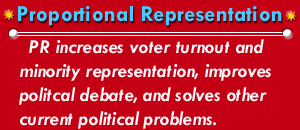PR: Intro and Definitions
 Many Americans believe that the two major parties are inadequate and that
an out-of-touch and unrepresentative political class now governs the
nation. While most of the world's leading democracies have adopted
proportional voting systems to mandate more representative government,
America lags. Establishing proportional representation (PR) in
America would increase voter turnout, produce a more intelligent political
debate, improve minority representation, and solve many of the
problems of the current political culture.
Many Americans believe that the two major parties are inadequate and that
an out-of-touch and unrepresentative political class now governs the
nation. While most of the world's leading democracies have adopted
proportional voting systems to mandate more representative government,
America lags. Establishing proportional representation (PR) in
America would increase voter turnout, produce a more intelligent political
debate, improve minority representation, and solve many of the
problems of the current political culture.
Proportional Representation Defined
The current national electoral system is based on geographically defined, winner-take-all,
districts. America is divided into 435 Congressional districts that each elect one member to the House of Representatives; similar geographic divisions are used in many state
legislative districts. Although this approach allows each region to be represented, it only allows an ideological group to be represented if its views are the most popular in a particular district. The result is a Congress where 534 of 535 representatives are from either the Democratic or the Republican Party even though most Americans identify with neither party and would choose viable third alternatives if they
existed.
 Proportional representation utilizes larger, multi-member districts in an attempt to achieve more accurate ideological matches between politicians and voters. In other words, each state has fewer congressional districts, but each district has more seats, so voting for a "third" party candidate is not necessarily a waste of a vote. As a direct result, a variety of political parties emerge with nearly every major political perspective gaining a voice in the legislature. 34 out of the 36 most democratic nations use some form of PR for their national legislature. John Stuart Mill, Alexis de Toqueville, Clarence Thomas, Robert F. Kennedy, and Franklin D. Roosevelt have all voiced support for PR in America.
Proportional representation utilizes larger, multi-member districts in an attempt to achieve more accurate ideological matches between politicians and voters. In other words, each state has fewer congressional districts, but each district has more seats, so voting for a "third" party candidate is not necessarily a waste of a vote. As a direct result, a variety of political parties emerge with nearly every major political perspective gaining a voice in the legislature. 34 out of the 36 most democratic nations use some form of PR for their national legislature. John Stuart Mill, Alexis de Toqueville, Clarence Thomas, Robert F. Kennedy, and Franklin D. Roosevelt have all voiced support for PR in America.









